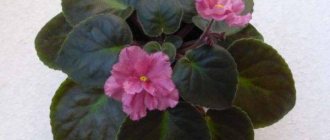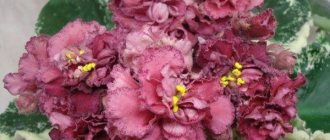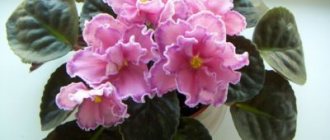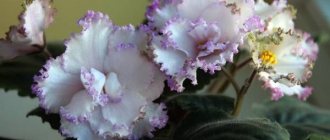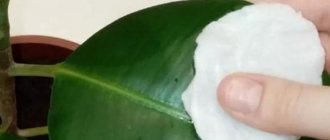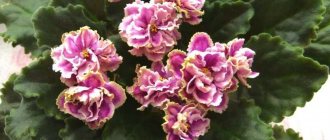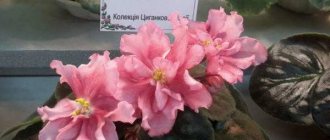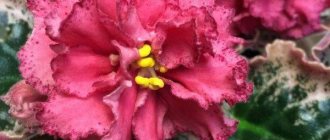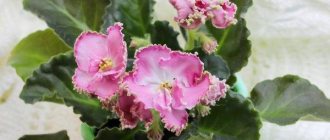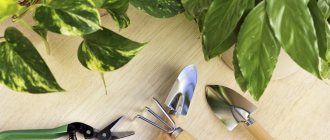Most representatives of the Saintpaulia genus live in the mountainous regions of East Africa . In Russia, this indoor plant appeared at the very beginning of the 20th century, and was the property of botanical gardens and private greenhouses.
The active selection of Uzambara violets in the USSR
began in the late 40s and early 50s of the last century. One of the founders of the theory and practice of developing new varieties of Saintpaulia was the married couple Boris Mikhailovich and Tatyana Nikolaevna Makuni.
Violet SM-Eternal May (Seedling Morev)
Genus, family
The variety belongs to the botanical genus Saintpaulia of the Gesneriaceae family.
History of the variety
The Eternal May variety was created by a talented Russian breeder, a student of Boris Makuni, Konstantin Morev. Programmer education allows you to: with mathematical precision:
- Calculate series of violet variability;
- And create varieties of rare beauty.
In his work, Konstantin chose several directions. Its varieties undergo strict selection , and only a few are presented to the viewer. Violets bred by Morev are characterized by:
- Variegation;
- Tricolor corollas;
- Green border on petals.
ATTENTION! The peculiarity of these varieties is the very long life span of each flower.
Photo and description of the variety
SM-Eternal May (seedling by K. Morev) - bright pansies collected in a dense bouquet. On the petals:
- Large bright scarlet or cherry spots;
- And emerald ruffle.
Sweet violet Eternal May.
Saintpaulia foliage
- Rich emerald color;
- The edge is serrated;
- The surface of the plate is quilted.
The leaves are collected in a symmetrical dense rosette .
The size of the corolla is average; for the “pansy” type this is a large modification .
Sports
The sport is characterized by leaves with:
- Wavy crenate edge;
- And a terry whisk.
This variety has sports.
Caring for a plant at home
Usambara violet is a common resident of our window sills . It is not difficult to care for her, the most important thing is:
- Attention;
- And an individual approach to each plant.
In order for violets to delight with abundant flowering and beautiful foliage, they need :
- Proper care;
- And under optimal conditions.
Proper watering and fertilizing
Water violets only when the top layer of soil in the pot has dried out . An individual approach is important here.
Different plants, depending on age, size, soil composition, size and material of the pot, need watering at different intervals. By watering all the plants in your collection at the same time, you risk:
- Fill some of them;
- And dry out others.
The water needs to sit for several hours.
ADVICE! For watering, use a watering can with a thin long spout or a syringe (50-100 ml in volume). A thin stream of water is directed to the edge of the pot, to the border with the substrate, making sure that the drops do not fall on the petioles and the growing point.
It is advisable to choose liquid fertilizers as fertilizers. They are easier to introduce. When adding additional food, follow the following rules :
- Nitrogen fertilizing is needed only during the period of green mass growth;
- Potassium and phosphorus stimulate long-lasting, abundant flowering;
- Microelements will help withstand unfavorable conditions;
- When choosing between fertilizing and replanting, choose replanting.
For the good health of Saintpaulia, fertilizing is necessary.
Lighting and temperature
Violets prefer bright but diffused sunlight on eastern and western windowsills .
In strong light, the rosette of the variety can become semi-mini , but the flowering does not become worse.
is not enough light :
- The leaves rise up;
- The rosette becomes like the blades of a helicopter rotor.
Air humidity
A resident of river banks, Saintpaulia, is very demanding in terms of maintenance :
- Moisture in the air;
- And the substrate.
These plants feel best at an air humidity of 50-60%. A healthy adult violet, with regular watering and optimal lighting, feels good at 40%.
What kind of soil does he prefer?
Based on the experience of flower growers, purchased soil for violets is rarely suitable. must contain .
Basic soil requirements for Saintpaulias:
- Moisture capacity;
- Air permeability;
- Sufficient content of potassium and phosphorus, nitrogen should not be in excess;
- Acidity 5.5-6.5;
- Favorable microflora;
- No pests or diseases.
You can collect soil for violets yourself.
to independently compiling a soil mixture for violets :
- An extremely simple substrate of high-moor peat and cultivators (vermiculite, perlite, charcoal). With this approach, the plants will need regular feeding;
- Preparation of a complex mixture balanced in chemical composition. When using it, fertilizing is practically not required.
Pruning and hygiene
An adult violet bush must be shaped. The foliage should overlap each other, like tiles on a roof. Peduncles form in the leaf axils . Therefore, without a healthy, strong rosette, active flowering cannot be achieved.
Usually the bush consists of 3-4 tiers of leaves . The lower ones begin to fade, turn pale, they are removed, just like:
- Empty flower stalks;
- Sick, damaged leaves.
ADVICE! As the bush grows and leaves are removed, the plant's stem becomes exposed; it needs to be sprinkled or buried when replanting.
Dust accumulating on the fluffy leaves of violets;
- Spoils the appearance;
- And it harms gas exchange.
A hygienic shower will help get rid of it . After protecting the soil with a film, rinse each leaf under a thin stream of warm water. After showering, be sure to let the plants dry in the shade.
Methods of propagation of the variety
Most often, Saintpaulia is propagated by leaves.
The variety reproduces well. The simplest ways :
- Leaf cuttings. You can root in water and in soil. Roots and children form very quickly;
- Kids. Eternal May is prone to the formation of children. They produce roots even faster than leaf cuttings.
Transplant rules, rejuvenation
Saintpaulias are replanted every 1.5-2 years . Remaining in the same soil longer, the plant stops blooming. The size of the pot can be left the same when replanting. The easiest time for the plant to undergo this procedure is in March.
The main task of replanting is to give the plant the opportunity to grow a young root system , which will give the plant strength to form strong leaves and flower stalks.
Transplantation is an excellent reason to rejuvenate the plant; it is carried out according to the following algorithm :
- The soil must be dried so as not to damage the roots during transplantation;
- Remove the root system, freeing it as much as possible from the compacted substrate;
- Remove old leaves that have lost their elasticity;
- If the violet is more than 2 years old, cut off the old roots;
- Place the roots in fresh soil, covering them up to the level of the leaves;
- After some time, when the soil settles from watering, you can fill it up.
IMPORTANT! It takes about a month for Saintpaulia to settle into new soil.
Detailed examination of the life stages of a seedling
Ease of caring for a seedling is achieved due to the fact that the rhythms of its life activity coincide with the standard course of biological processes in most Saintpaulias. The violet grower can only adjust the general scheme of agrotechnical schedules with the individual nuances of the seedling.
Specificity of development in indoor collections
Being a harmoniously developed plant, the seedling can be considered an ideal option for flower growers who want to add to their collections, as well as for beginning violet collectors.
He has many positive qualities with minimal negative touches in his development.
As favorable features of a seedling, one can highlight the following useful characteristics :
- Independent distribution of rosettes of sheet plates into tiers;
- Fast and harmonious development of bushes;
- Ease of reproduction;
- Vigorous cap flowering in large volumes already during the initial waves of budding with long-term preservation of the decorative appearance of flowers;
- The brightness and refined texture of large corollas;
- Almost varietal repetition of the color scheme of the buds;
- Flowering with the same intensity both on the window and on the shelf;
- Low level of dependence on minor violations in containment regimes.
The seedling, like all violets, has several unpleasant nuances in the specifics of development:
- Dependence on heat, to one degree or another, is characteristic of most K. Morev violets - at high temperatures they float in a range of colors;
- Disappearance of white color when illuminated by lamps;
- The need to control the watering regime - the seedling loves to drink water, you cannot miss the moment of severe drying out of the soil;
- The heaviness of flower caps, which is why flowers can lie on the rosette.
Growing violet according to timing
The seedling blooms, which means it becomes an adult, somewhat earlier than most violets. But the timing of the teenage phase depends on the method of obtaining young specimens :
- If you take the baby from a leaf cutting, the stage will take a little less than eight months after the embryo is laid;
- If you use the stepson from the mother violet, the period will be reduced even more.
Features of reproduction
In the arsenal of gardeners for obtaining young specimens of seedlings there are only two vegetative techniques:
- Children from leaf cuttings;
- Stepchildren from the mother plant.
Propagation of seedlings using seeds is not recommended - there is a high probability of losing all its distinctive features.
Flower response to temperature
The seedling depends on changes in the temperature gradient :
- In a cool room, the color of the flowers can become white with barely noticeable lilac prints;
- And at high temperatures, the color “floats” to an even, thick purple tint.
CAREFULLY! Violet flowers and buds react extremely negatively to temperature changes and drafts!
Pedicel strength
The seedling's peduncles have a strong structure, optimal height and considerable strength, but due to the weight of the voluminous caps, even these peduncles can drop flowers onto the leaves of the rosette.
Flowering type
Saintpaulia almost immediately produces large flowers of double texture and wants to form caps, but the maximum expressiveness of the flowering of the seedling is achieved after several waves. Heavy caps of very terry corollas appear.
This Saintpaulia has lush flowering.
Lifespan of a flower
General flowering occurs over a long period due to the fact that each flower retains a healthy decorative appearance for about a month.
Features of flowering, growth and reproduction
Seedling Eternal May:
- Easy to care for;
- Growing and developing rapidly;
- Easy to reproduce.
The presented violet blooms magnificently under comfortable conditions.
Prefers natural light. When artificial, the corollas float pink.
How long does it take to grow an adult plant?
goes through several stages from a leaf cutting to an adult plant :
- Formation of roots on cuttings – 3-4 weeks;
- The appearance of babies is 5-6 weeks;
- Starter formation – 3 months;
- First flowering – 7-9 months.
How are varietal characteristics transmitted?
Eternal May reproduces willingly and produces many children .
Flowering in hot and cool conditions
This seedling variety produces flowering that matches the description at temperatures of 23-240C . In cooler conditions it produces lighter flowers and a brighter ruffle. In the heat there may be no ruffles at all.
What do flower stalks look like?
Violet flower stalks:
- Dense;
- Strong.
The flower stalks of the Eternal May violet are very strong.
They do not grow vertically, but somewhat obliquely.
Is it possible to achieve cap flowering?
Blooms profusely . Peduncles are collected in a bouquet of impressive size.
Bud lifespan
During the winter months, the variety blooms for about 5 weeks , then breaks for 4 weeks, and blooms again. From spring to autumn, new flowers appear constantly.
Reviews
Veronica Olegovna. “ The charming seedling “SM-Moonlight Glitter” should appeal to those gardeners who grow violets of special fullness, and also love plants with iridescence of dense shades of violet and blue. The seedling will be especially suitable for novice violet growers due to its ease of care.”
The variety attracts the attention of many gardeners with its color.
